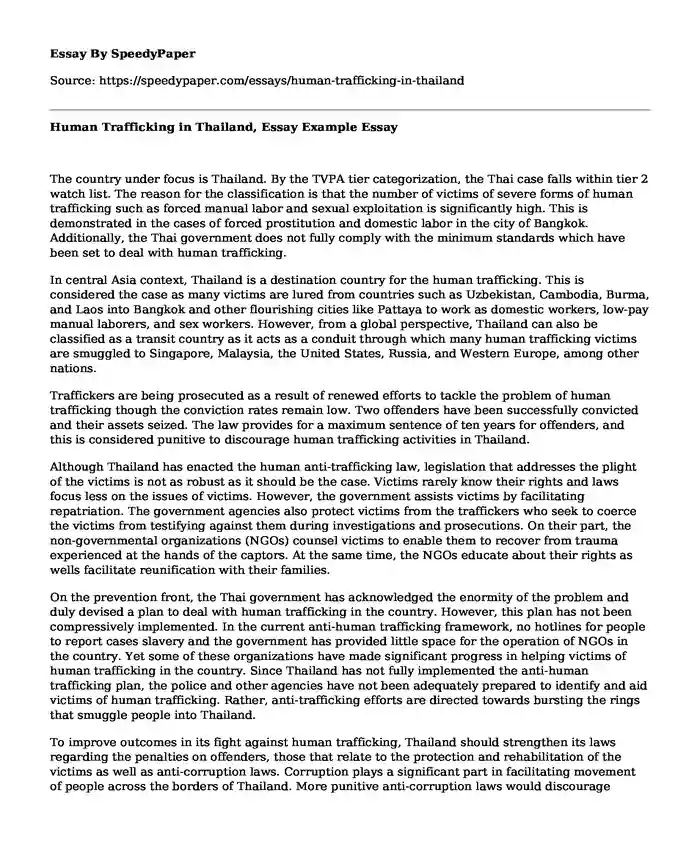
| Type of paper: | Course work |
| Categories: | Human trafficking |
| Pages: | 3 |
| Wordcount: | 658 words |
The country under focus is Thailand. By the TVPA tier categorization, the Thai case falls within tier 2 watch list. The reason for the classification is that the number of victims of severe forms of human trafficking such as forced manual labor and sexual exploitation is significantly high. This is demonstrated in the cases of forced prostitution and domestic labor in the city of Bangkok. Additionally, the Thai government does not fully comply with the minimum standards which have been set to deal with human trafficking.
In central Asia context, Thailand is a destination country for the human trafficking. This is considered the case as many victims are lured from countries such as Uzbekistan, Cambodia, Burma, and Laos into Bangkok and other flourishing cities like Pattaya to work as domestic workers, low-pay manual laborers, and sex workers. However, from a global perspective, Thailand can also be classified as a transit country as it acts as a conduit through which many human trafficking victims are smuggled to Singapore, Malaysia, the United States, Russia, and Western Europe, among other nations.
Traffickers are being prosecuted as a result of renewed efforts to tackle the problem of human trafficking though the conviction rates remain low. Two offenders have been successfully convicted and their assets seized. The law provides for a maximum sentence of ten years for offenders, and this is considered punitive to discourage human trafficking activities in Thailand.
Although Thailand has enacted the human anti-trafficking law, legislation that addresses the plight of the victims is not as robust as it should be the case. Victims rarely know their rights and laws focus less on the issues of victims. However, the government assists victims by facilitating repatriation. The government agencies also protect victims from the traffickers who seek to coerce the victims from testifying against them during investigations and prosecutions. On their part, the non-governmental organizations (NGOs) counsel victims to enable them to recover from trauma experienced at the hands of the captors. At the same time, the NGOs educate about their rights as wells facilitate reunification with their families.
On the prevention front, the Thai government has acknowledged the enormity of the problem and duly devised a plan to deal with human trafficking in the country. However, this plan has not been compressively implemented. In the current anti-human trafficking framework, no hotlines for people to report cases slavery and the government has provided little space for the operation of NGOs in the country. Yet some of these organizations have made significant progress in helping victims of human trafficking in the country. Since Thailand has not fully implemented the anti-human trafficking plan, the police and other agencies have not been adequately prepared to identify and aid victims of human trafficking. Rather, anti-trafficking efforts are directed towards bursting the rings that smuggle people into Thailand.
To improve outcomes in its fight against human trafficking, Thailand should strengthen its laws regarding the penalties on offenders, those that relate to the protection and rehabilitation of the victims as well as anti-corruption laws. Corruption plays a significant part in facilitating movement of people across the borders of Thailand. More punitive anti-corruption laws would discourage bribery of immigration officials and border patrols that aid trafficking rings in transporting victims to their desired destinations. Heavier penalties would scare traffickers while improved protection laws would ensure more victims come up to speak about their plights without fear of reprisals from the trafficking rings or prosecution from the Thai authorities for being in the country illegally. Further, the Thai government should provide more operational space for NGOs to augment the efforts of the government's anti-trafficking agencies.
References
Behind the Incredible World. (2015, April 22). 21st Century Sex Slaves and Human Trafficking [Video file]. Retrieved from https://www.youtube.com/watch?v=p64yu404F7k
MTV. (2011, June 11). MTV EXIT Thailand Human Trafficking Documentary /BMRS - Asia with English Sub (Part 2) [Video file]. Retrieved from https://www.youtube.com/watch?v=98XnMp6Lkm8
Cite this page
Human Trafficking in Thailand, Essay Example. (2022, Jun 22). Retrieved from https://speedypaper.net/essays/human-trafficking-in-thailand
Request Removal
If you are the original author of this essay and no longer wish to have it published on the SpeedyPaper website, please click below to request its removal:
- Free Essay Researching How International Students Consume Alcohol
- Essay Example with a Reflection Paper about an Article
- Art Essay Sample Describing the Carybe Painting
- Free Essay Sample: Sustainable Design for a House in the Tropics
- Essay Samples: The Unexpected Friendship. The Role of MP3 Players.
- Free Essay with a Language Development Lesson Plan
- Free Essay Sample on Hassan's Motivation for the Attack
Popular categories




